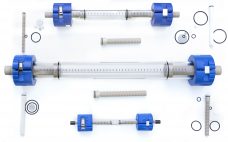Structure is an important characteristic for protein activity and function. Structural alterations due to protein mis-folding, denaturation or unfavorable conditions can lead to the formation of aggregate species that can affect the efficacy and safety of biologic drug candidates. While many biophysical analytical tools are well suited for detecting these aggregates, few offer a combination of structural and functions assessment in the same system. Sartorius’ Octet® platform is an easy-to-use analytical tool that can detect the presence of aggregated species…
Sponsored Content
Ask the Expert: FPLC Column Selection Considerations
On 10 November 2020, BPI presented an “Ask the Expert” webinar with Dan Yukon (head of North American and global SNAP product sales at Astrea Bioseparations) on considerations for selecting analytical fast-protein liquid chromatography (FPLC) columns. With many options on the market, deciding which type and brand to use can be difficult. To help take out the guesswork, Yukon addressed a number of topics, including pressure and volume considerations; column configuration; materials of construction; frit type, design porosity, and mounting;…
Ask the Expert: Centrifugation Guided By Optical Sensors Enables Efficient, Reagent-Free Cell Separation
Ben Josey, PhD (field application scientist at Corning Life Sciences), joined BPI on 3 December 2020 to deliver an “Ask the Expert” presentation about using optical-sensor–guided centrifugation for cell therapy development. Cell-separation techniques fall into four basic categories: filtration, centrifugation, affinity purification, and emerging methods such as microfluidics and acoustofluidics. Selecting the technology best suited to an application requires careful balancing of method precision and process efficiency, the latter of which includes factors such as batch size, time, labor, and…
Ask the Expert: New and Improved Analytical Methods for Traditional and Unique Modalities
On 10 December 2020, BPI presented an “Ask the Expert” webinar with Jason Sterling, PhD (principal scientist and project director in analytical and formulation resources), and John Rockwell (group leader) of Catalent Pharma Solutions. Biophysical characterization is critical to understanding the makeup and behaviors of biologic therapies and vaccines both early in development and throughout scale-up for manufacturing. As biologics become more complex in structure and as scientists improve their understanding of the effects of structure on stability, efficacy, and…
Ask the Expert: Developing Strategic Analytical Programs for Therapeutic Peptides
Ashleigh Wake began her 15 October 2020 “Ask the Expert” presentation by pointing out that peptide products are manufactured in a “regulatory vacuum.” Peptide-product developers must be strategic in designing characterization and quality control (QC) programs. Wake reviewed available methods and explored key considerations for developing phase-appropriate analytical controls. Wake’s Presentation Because peptides overlap small- and large-molecule drugs in size, regulatory expectations differ by product size and clinical indication. Thus, analytical programs should be designed around critical quality attributes (CQAs)…
Stem Cell Derived Exosome Production in Stirred-Tank Bioreactors
This webcast features: AurĂ©lie Tacheny, Project Manager and Application Specialist, and Jorge Escobar Senior Research Scientist, Applications Lab, Eppendorf Exosomes are a population of naturally occurring, mobile, membrane-limited, 30–100 nm in diameter, extracellular vesicles containing a large number of proteins, lipids, messenger, and micro-RNAs. It was shown that they play a role in the mediation of intercellular communication, the modulation of immune-regulatory processes, tumor metabolism, and regenerative as well as degenerative processes. In recent years, there has been increasing interest…
Eurofins on how to get faster sterility results
Due to the 14-day incubation requirement for compendial sterility, this is often the last data available when testing BioPharmaceutical products for release or stability. So turnaround time pressure has always been an inherent part of sterility testing. This pressure has become more acute with the emergence of ATMPs, particularly autologous cell therapies which are often given to patients before traditional testing results can be obtained. Eurofins BioPharma Product Testing has responded to the demand for faster sterility results by streamlining…
MS-Based Impurities Investigations in Biopharmaceutical Laboratories
This webcast features: Andrew Hanneman, Scientific Advisor, Charles River Laboratories One of the major challenges to developing successful biopharmaceutical products is understanding and characterizing potential impurities. Finding the source and magnitude of these impurities allows us to minimize and remove them during the manufacturing process to create a safe and effective drug. Development also needs to include supporting stability and forced degradation studies to ensure long-term safety and efficacy. Some impurities, such as protein degradants, host cell proteins, and various…
New Data: A Better Way to Run CHO Cell Culture Experiments
This webcast features: Deborah Pascoe, PhD, Vice President of Operations, Culture Biosciences The bench-scale bioreactor has been the workhorse of Chinese hamster ovary (CHO) cell culture process development for decades. However, running benchtop bioreactors requires significant resources, infrastructure, and staffing. Tubing assembly, sterilization, calibration, and other setup activities can take hours to days. Tear down, cleaning, and deactivation are similarly burdensome. There are potentially large associated costs to prepare or purchase media, carry seed trains, and maintain facilities. Most critically,…
Transfection Reagents for Cell and Gene Therapy
Polysciences offers high-quality, R&D and cGMP grades of transfection reagents for the smooth transition from process development through clinical trials and commercial manufacturing of viral vectors/protein. Polysciences R&D grade PEI MAX has been used by academic and industry customers for over a decade and is one of the most cited transfected reagents. A few years ago Polysciences launched an easy to use liquid version of PEI MAX which is called Transporter 5 focusing on increased customer convenience. Both PEI MAX…







